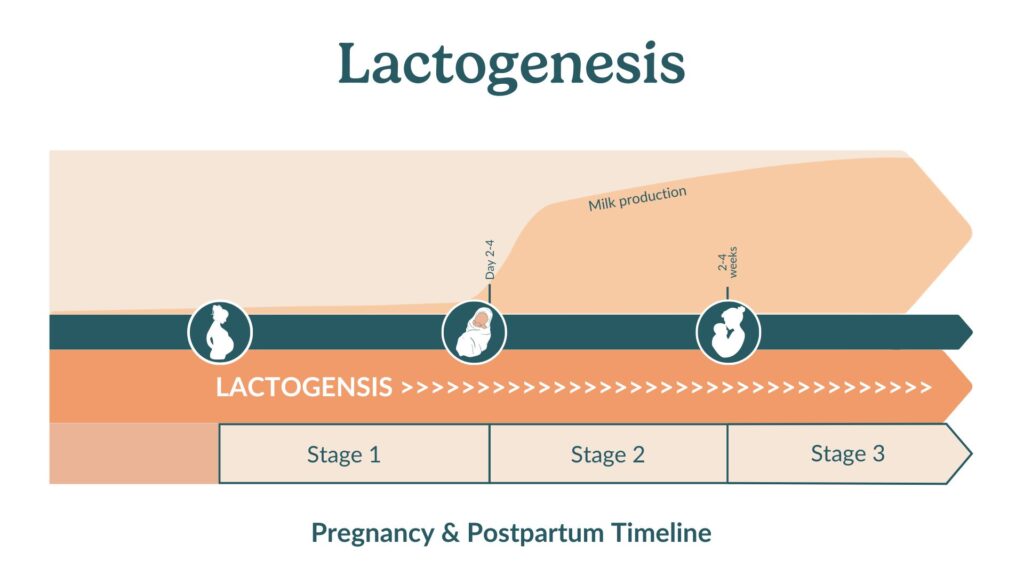lactogenesis

Lactogenesis
Lactogenesis is the process of milk production in the breast, which occurs in three stages: Lactogenesis I, II, and III.
The stages of lactogenesis
Here are the three stages of lactogenesis and what to expect during each:
1. Lactogenesis I (Initiation):
- Timing: Begins during the second trimester of pregnancy and continues until about two days postpartum.
- Description: This stage involves the development of the mammary glands and the production of colostrum, the first milk. Colostrum is rich in antibodies and nutrients, providing essential immune support for your newborn.
2. Lactogenesis II (Milk "Coming In"):
- Timing: Starts around the third to fifth day after birth and lasts until about 10-14 days postpartum.
- Description: This stage is marked by a noticeable increase in milk volume and a change from colostrum to transitional milk. Your breasts may feel fuller and heavier as milk production increases. This milk is higher in fat and lactose, supporting your baby's growth and energy needs.
3. Lactogenesis III (Maintenance):
- Timing: Begins around two weeks postpartum and continues for the duration of breastfeeding.
- Description: Mature milk is produced, and milk supply is regulated by supply and demand. Frequent nursing or pumping helps maintain milk production, ensuring your baby gets the nutrition they need.
What to watch out for
Understanding lactogenesis can help you navigate the early days of breastfeeding.
Here are some key points to consider:
- Engorgement: During Lactogenesis II, you may experience engorgement as your milk "comes in." Nurse frequently and maintain a good latch to help avoid or relieve engorgement and promote milk flow. Read more about managing engorgement.
- Changes in milk: Notice the transition from colostrum to transitional milk and then to mature milk. This is a normal part of lactogenesis and indicates that your milk production is progressing.
- Milk supply: Monitor your baby’s feeding patterns and diaper output to make sure they are getting enough milk. If you’re concerned about your milk supply, consult a lactation consultant for personalized advice. Read more about increasing milk supply.
Physical limitations or health circumstances
Certain conditions can affect the stages of lactogenesis:
- Hormonal imbalances: Conditions like polycystic ovary syndrome (PCOS) or thyroid disorders can interfere with milk production. Managing these conditions with your healthcare provider is important.
- Previous breast surgery: Surgeries such as reductions or augmentations might impact milk ducts and glandular tissue, affecting milk production. Discuss your surgery history with a lactation consultant for advice.
- Diabetes: Mamas with diabetes may experience delayed onset of Lactogenesis II. Close monitoring and support from a healthcare provider can help manage this.
Other terms
Understanding related terms can help you better navigate lactogenesis and breastfeeding:
- Colostrum: The first milk produced, rich in antibodies and nutrients. It is present during Lactogenesis I and transitions to mature milk.
- Transitional milk: The milk produced during Lactogenesis II, which is higher in volume and nutrient-rich, transitioning from colostrum to mature milk.
- Mature milk: The milk produced during Lactogenesis III, providing a balanced mix of nutrients, fats, and antibodies for your baby’s growth.
- Prolactin: The hormone responsible for milk production, which increases during pregnancy and breastfeeding to stimulate lactogenesis.
- Oxytocin: Known as the "love hormone," it causes the muscles around the alveoli to contract, pushing milk into the ducts and to your baby. It plays a crucial role in milk let-down. Read more about oxytocin.
- Let-down reflex: The reflex that releases milk from the alveoli into the ducts, allowing it to flow to your baby. Effective let-down is crucial for milk transfer. Read more about let-down reflex.
- Milk supply: The amount of milk produced by your breasts. It is regulated by the frequency and effectiveness of nursing or pumping. Read more about increasing milk supply.


